Rhabdoviridae
Enveloped, nonsegmented, (-), ss RNA Group V
Historical Notes
- Rabies virus was recognized in Egypt before 2300 B.C. and was described by Aristotle in ancient Greece.
- It has been characterized by many as one of the oldest and most feared diseases of both animals and man.
- It is the most lethal of all infectious diseases and has the widest host range of any virus.
- It was also responsible for inspiring one of the most significant biomedical discoveries in history.
- In 1885 Louis Pasteur developed the rabies vaccine during a time when the nature of viruses was still a mystery.
- It was the success of this vaccine that inspired scientists to prevent infectious diseases by vaccination.

Source: Steven K. Vernon, of Wyeth-Ayerst Research
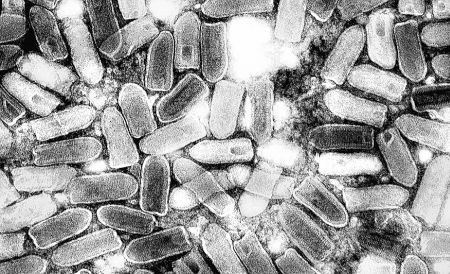
Source: F. Murphy, UC, Davis, CA.
Morphology
Virions are bullet-shaped with 10-nm spike-like glycoprotein peplomers covering the surface.
70 x 180 nm in size.
Some are bacilliform.
Lipid-rich envelopes (20% lipids, 13% carbohydrate, 2-3% RNA, and the remainder is protein).
Spikes are 5-10 nm.
The simplest of the negative-sense viruses.
Transcriptase activity inside the helical nucleocapsid.
Helical nucleocapsid or ribonucleoprotein (RNP) core that gives them characteristic shape is made up of an N(nucleocapsid) protein.
Helical nucleocapsid wrapped into a spiral that tapers at one end but not the other.
The envelope is covered by prominent spikes that are the product of a single viral gene (the G gene).
Envelope contains an external glycoprotein (G) and internal matrix (M) proteins.
M lines the inner surface of the viral membrane.
The M protein is also a phosphoprotein, located beneath the envelope, which in turn consists of G and host cell membrane lipids.
Most effective antibody responses are directed against the G protein.
In many species, control can be achieved by immunization with the G protein alone.
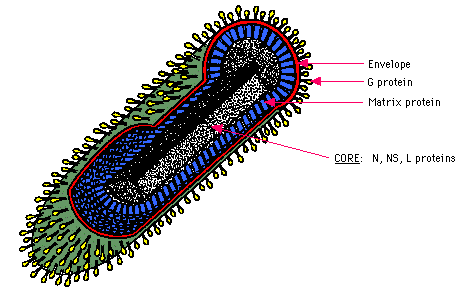
Source: microbiology-bytes
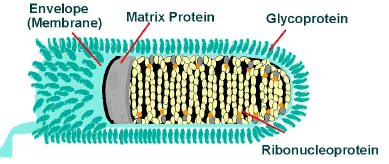
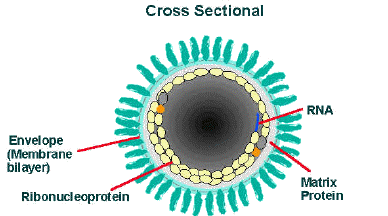
Source: CDC
Taxonomy
Order: Mononegavirales
Family: Rhabdoviridae (originated in Africa)
Genera:
Lyssavirus (rabies and rabies-like viruses)
Cytorhabdovirus (lettuce necrotic yellow virus)
Ephemorovirus (bovine ephemeral fever virus)
Novirhabdovirus (infectious hematopoietic necrosis virus)
Nucleorhabdovirus (potato yellow dwarf virus)
Vesiculovirus (Vesicular stomatitis virus - VSV)
VSV is easy to grow in tissues, it is the preferred model system to study the biology of Rhabdoviruses and those within the order Mononegavirales.This arbovirus infects insects and mammals.
There are a large number of rhabdoviruses that have not yet been assigned to a genus.
A well-defined family with more than 150 members with a wide host range (including fish), arthropods, amoebas, and plants.
Some can infect not only species in different classes in the same kingdoms (mammals and insects), but also members of entirely different kingdoms (insects and plants).
The ability to attach to such vastly different cell types suggests that the virus recognizes a surface constituent common to many different cells.
Genome
Non-segmented, ss, (-) RNA, monopartite.
11 kb overall size.
The entire rabies genome has now been cloned, sequenced and expressed.
There is a conserved polyadenylation signal at the end of each gene and a short intergenic region between each of the 5 genes.
They typically carry genes for five proteins: large protein (L), glycoprotein (G), nucleoprotein (N), phosphoprotein (P), and matrix protein (M).
The P structural protein is highly phosphorylated by the host cell kinases and becomes complexed with L to form a functional enzyme.
A replicase complex has been identified within the cell that gives rise to the (+) sense RNA.
Nucleotide sequences of 3'-terminus are inverted and complementary to similar regions on the 5' end. 5' terminus has a triphosphate. 3' terminus has no poly (A) tract.
The ssRNA isolated from these viruses is not infectious, since it lacks the enzyme that can replicate it and it cannot act as messenger until it has been replicated or at least transcribed to a (+) strand.
The genetic arrangement is similar to that of paramyxoviruses, with a conserved polyadenylation signal at the end of each gene and short intergenic regions between the five genes.
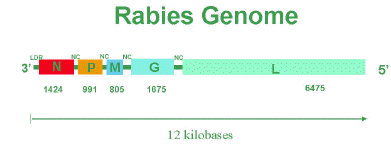
Attachment
Protein G attaches to receptor on a cell surface.
Specific receptor is unknown but is probably a common constituent of a cell membrane, because the cellular host range is so diverse.
Rabies virus is suspected to bind to nicotinic acetyl-choline receptor on neurons of mammalian cells.
The VSV attaches to phosphatidylserine.
Penetrates by endocytosis by a temperature and low-pH process.
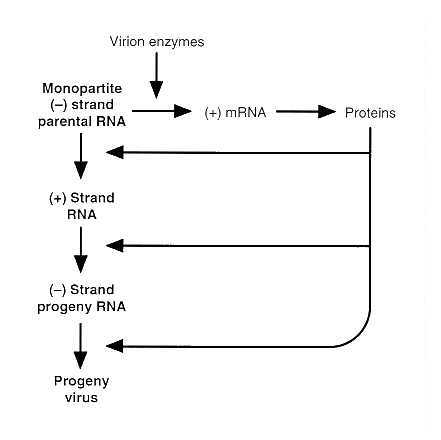
Replication
Some aspects of replication such as the action of some polymerases are not well understood.
RNA is transcribed inside the cytoplasm.
They first transcribe a positive RNA template, then use that template to regenerate their negative RNA genome.
Synthesis of mRNA involves the transfer of information from one ssRNA to its complementary RNA and requires a pre-existing RNA-dependent RNAP.
The first step of RNA synthesis results in a series of mRNAs made from the various genes of the virus.
The second is a (+) strand RNA that is a COPY of the complete viral genome.
These long (+) strand RNAs then serve as templates for synthesis of (-) strand RNAs, which will serve as genomes of progeny virions.
Each of the 5 mRNAs is monocistronic, coding for a single protein.
Translation of viral mRNAs leads to the synthesis of viral coat proteins in ribosome complexes in the cytoplasm.
Assembly of an enveloped virus is considerably more complex than assembly of a simple virus particle.
Assembly of the virion proceeds in the same manner as with all enveloped RNA viruses.
Replication characteristically occurs in an inclusion body within the cytoplasm, from where they bud through various cytoplasmic membranes and the outer membrane of the cell.
This process results in the acquisition of the M + G proteins, responsible for the characteristic bullet- shaped morphology.
The envelope carries small amount of certain host proteins (e.g. MHC molecules).
The budding process itself does not cause detectable damage to the cell, which may continue to release virions for a considerable period of time.
Host damage does occur but is brought about by other unknown factors.

Source: microbiolog-bytes
Transmission
Normal hosts for the rabies virus are foxes, dogs, cats, bats, skunks, etc. while man is a dead-end infection for the virus.
Dog rabies is an important human concern as the virus in the saliva of infected dogs is responsible for majority of the 75,000 cases of human rabies that occur each year worldwide.
The most common transmission of rabies is via the bite of a rabid animal which usually results in the deposition of rabies infected saliva into the striated muscle.
Transmission of the virus can also occur after a superficial abrasion of the skin and in some environments, such as bat caves, where the amount of virus may be high, it can be transmitted via aerosol.
Human to human transmission via saliva has been reported but has not been substantiated.
The virus initially replicates in the muscle cells or cells of the subepithelial tissue.
Then when its concentration is sufficient to infect the motor and sensory nerves in the muscle or skin it binds the acetylcholine receptors or other receptors entering the nerve endings.
The virus is then delivered to the central nervous system via axons in the spinal cord.
The infected individual may experience two forms of the virus depending on the location of neuronal infection.
Furious Rabies
Virus replicates in the limbic system.
Manifests as headache, fever, irritability, restlessness, and anxiety.
Muscle pains, salivation and vomiting may follow.
A few days following exposure the patient may experience a stage of excitement or muscle spasms initiated from the ingestion of saliva or water.
As a result these individuals have a tendency to drool and begin to fear water (hydrophobia).
This excited phase continues for a few days until the patient lapses into a coma and dies.
Dumb Rabies
Virus replicates in the neocortex.
Manifests itself in the opposite manner as furious rabies.
Instead of demonstrating excitement the patient experiences depression and paralysis followed by a coma.
Death eventually results from respiratory arrest.
This form of the virus is often difficult to diagnose from a clinical perspective.
